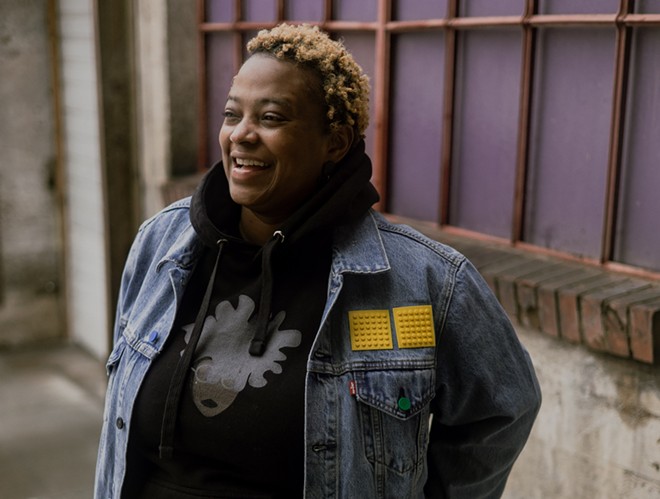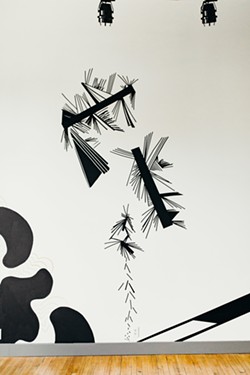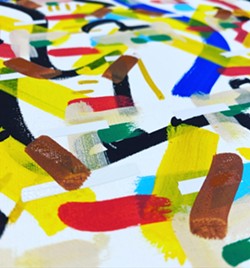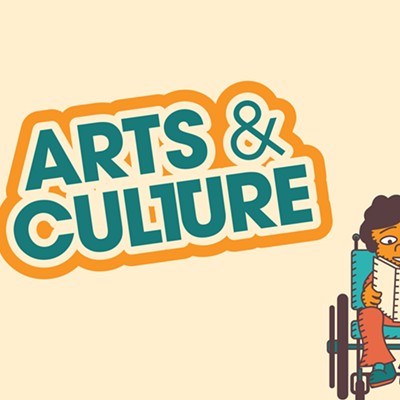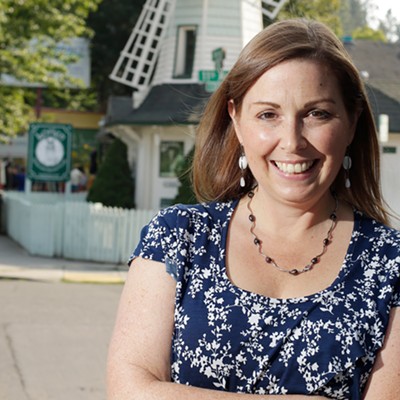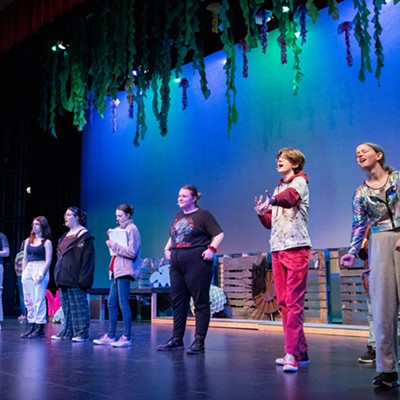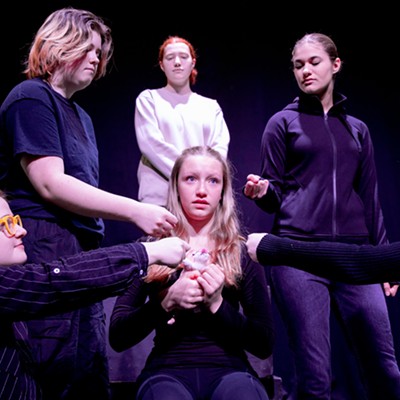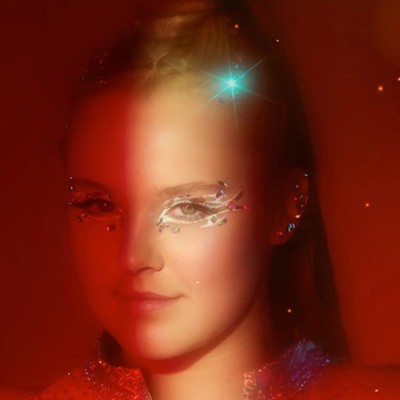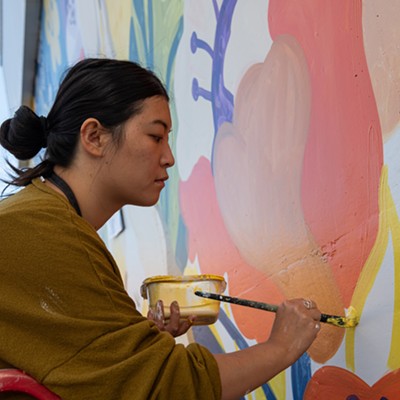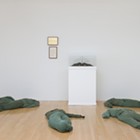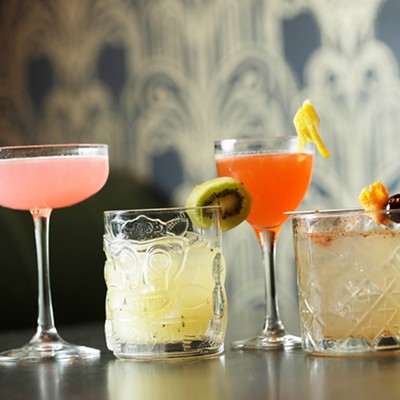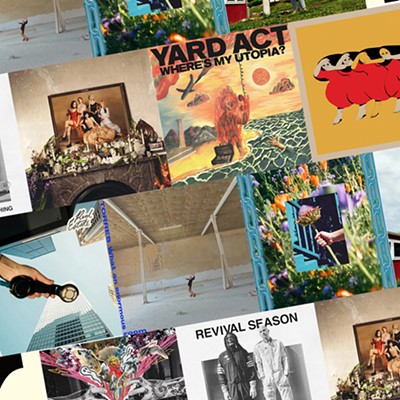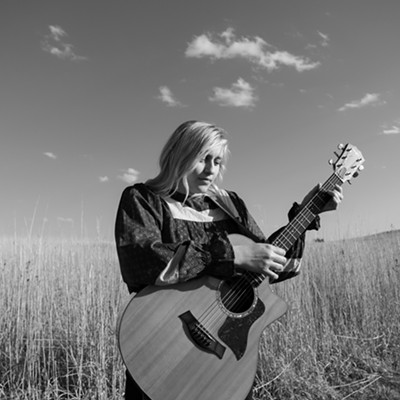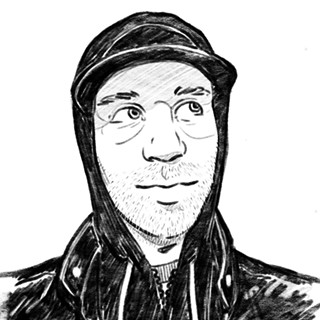Inlander Insights: Spokane Arts' Shantell Jackson
Assessing the local art community with the organization's new program director and curator as we head into 2022
[
{
"name": "Broadstreet - Instory",
"component": "25846487",
"insertPoint": "4",
"requiredCountToDisplay": "4"
},{
"name": "Broadstreet - Empower Local",
"component": "27852456",
"insertPoint": "8",
"requiredCountToDisplay": "8"
},{
"name": "Broadstreet - Instory",
"component": "25846487",
"insertPoint": "12",
"requiredCountToDisplay": "12"
},{
"name": "Broadstreet - Instory - 728x90 / 970x250",
"component": "27852677",
"insertPoint": "18",
"requiredCountToDisplay": "18"
},{
"name": "Broadstreet - Instory",
"component": "25846487",
"insertPoint": "5th",
"startingPoint": "23",
"requiredCountToDisplay": "24",
"maxInsertions": 100
}
]
Shantell Jackson excels at not just staying in one lane. One moment the multimedia artist will be painting, the next presenting poetry, then designing digital works, then freehand ink drawing, and so on. But the Buffalo, New York, native doesn't even draw hard lines between the genres, as her October 2021 joint Terrain Gallery exhibition with Tracy Poindexter Canton, Her Words to Life — which featured visual art inspired by Black American literary prose from women like Toni Morrison — showcased.
Also in October 2021, Jackson took on even a bigger role in the local artistic community, stepping in as the program director for Spokane Arts. It's the perfect landing spot for someone with a multidisciplinary approach to art. The nonprofit organization nurtures the art community through public and private grants, professional development, advocacy and programming. That programming includes Chase Gallery, which — after not being part of the monthly First Friday arts event for over a year — will return to the rotation this Friday, Jan. 7, with Layer by Layer, a group show featuring Madison Jones, Emily Somoskey and Aleeta Renee Jones.
To kick off 2022, we caught up with Jackson to chat about her curatorial role at Spokane Arts, cross-medium creation and ways that locals can support the artistic scene beyond monetary means.
What about the curator position at Spokane Arts appealed to you?
I am a visual artist and a writer, so moving through the past two years and a pandemic, I’ve just been getting clarity on the types of things that I want to be doing. And this position came up at just the right time. I'm able to kind of take my world of being a creative and now do it as an administrator. So what appealed to me was the opportunity to be able to work with other artists to help on projects that I think are needed for the arts community, for Spokane. And to really be innovative. One of my strengths is creative thinking and creative solutions. And I felt like this job would be the prime opportunity for me to be able to think creatively, innovatively for the city and art in Spokane.
What are some of those things that you feel are needed in the Spokane arts community that maybe haven't been supported enough?
I want to be careful because I think things come and go.
With that being said, I would love to look at communities: artist housing, artist communities. Especially during the pandemic, we saw how rent and just day-to-day living really transformed for people. I know a lot of cities have artist living communities, where like they pay reduced housing so that they can really focus on their art. So that's like long term.
But another thing that I think about is how to incorporate the youth in our communities. If we want you to stay in Spokane, give back to Spokane, or go [elsewhere] and [still] say they're from Spokane, how do we integrate them in the art community with more seasoned professionals? Not just something that’s “Oh, here's a youth art event,” but events that highlight seasoned and youth [artists on the same level]. Or like opportunities for apprenticeships for up-and-coming artists?
And then, of course, I always think about disparities. How does an arts organization uplift the art and the voices of those who have been historically marginalized in our culture, in our communities? What is the work that needs to be done there, and how do we do that better? I don't think I've had enough time to really come up with something definitive, but I'm definitely interested in exploring that more.
How does having a cross-disciplinary approach benefit your art, and how does it benefit you in your role at Spokane Arts?
In my own art, I often use a lot of materials and tools. I love to marry those worlds of visual art and writing; thinking about how writing can be incorporated in my visual works, and if there's a way to interpret visual works into writing. A prime example was this past October, Tracy Poindexter-Canton and I had a show in Terrain called Her Words to Life in which we focused on the words of Black women, Black authors, Black sentiments, and turned them into visual art pieces. And so it created this beautiful, beautiful installation that really just paid tribute and homage to Black womanhood.
And then as an administrator, I think I have a multidisciplinary approach. So just being able to think of things and now actually getting to work with artists, I think it makes me a little sharper too. Really just being able to see things from multiple lenses to come up with a solution, so I'm not really just stuck in one way.
What about the Spokane arts community excites you the most?
There's a wealth of creative folks here. And I don't think that people know that. And so I'm excited in this position to highlight and bring that to light more for those who want it. Some people are just creative because that's just what they want to do. They don't want notoriety, or they don't want their work to be out there like that.
But I think there are a good amount of people who probably do [want more exposure] and don't know where to get started. So how can I contribute to that? That is what excites me about this position in Spokane Arts. I mean, it’s a fairly young organization. Thinking about how to get more people involved in more opportunities, and [get] more people working on their projects.
The Spokane arts community is kind of small, right? Sometimes it feels like every artist is going for the same five opportunities, right? And so how do we create more opportunities? How do we empower artists to create opportunities that they want to see be here in Spokane [or beyond]? I know it's important to keep things county-wise, but I think art is meant to be shared globally. Art will change the world. And so how do we empower artists to do that?
What are the best ways for locals to support the Spokane artistic community?
I would say support artists, support their projects. I mean, I think there's sometimes so much red tape to go through. I understand you don't want to waste people’s time, but, like, really talk to an artist, talk to a creative.
When I say artists, I'm using that broadly, right? Talk to a dancer, a writer, a screenwriter. See what those ideas are. And if you can fund them, fund them. Give artists your money. [Laughs] Give artists your support.
Show off their work. The world at large is changing, and how we share information is changing. And so, I know sometimes it seems cringey, but seriously I think the best thing you can do is share with your networks if you bought a sticker or a poster from an artist.
If you have space, if you have tools, if you have like those things that you know artists need — like wide format printers or something — or if you know someone who knows someone who does, share that knowledge with artists.
There are just so many ways that you can support creatives that don't always involve money. It involves like, “Let me put you in contact with this person that I know who does this type of thing.” “Oh, you want to do that? Let me put you in contact with this person.” You know?
But, I mean, money is good. [Laughs]
Is there anything else you'd like to add?
I'm really just excited for the opportunity to really connect with artists, to connect with young people, to connect with the historically marginalized and underrepresented to see how we can build upon [what’s already in place] at Spokane Arts. How can we improve it, and really just change the world through art and creativity and all the fun stuff.
Layer by Layer • Jan. 7-Feb. 25 • First Friday: Fri, Jan. 7 from 4-6 pm • Chase Gallery • 808 W. Spokane Falls Blvd. • 509-321-9614
Editor's note: This post has been updated to reflect Jackson's job title.
Also in October 2021, Jackson took on even a bigger role in the local artistic community, stepping in as the program director for Spokane Arts. It's the perfect landing spot for someone with a multidisciplinary approach to art. The nonprofit organization nurtures the art community through public and private grants, professional development, advocacy and programming. That programming includes Chase Gallery, which — after not being part of the monthly First Friday arts event for over a year — will return to the rotation this Friday, Jan. 7, with Layer by Layer, a group show featuring Madison Jones, Emily Somoskey and Aleeta Renee Jones.
To kick off 2022, we caught up with Jackson to chat about her curatorial role at Spokane Arts, cross-medium creation and ways that locals can support the artistic scene beyond monetary means.
What about the curator position at Spokane Arts appealed to you?
I am a visual artist and a writer, so moving through the past two years and a pandemic, I’ve just been getting clarity on the types of things that I want to be doing. And this position came up at just the right time. I'm able to kind of take my world of being a creative and now do it as an administrator. So what appealed to me was the opportunity to be able to work with other artists to help on projects that I think are needed for the arts community, for Spokane. And to really be innovative. One of my strengths is creative thinking and creative solutions. And I felt like this job would be the prime opportunity for me to be able to think creatively, innovatively for the city and art in Spokane.
What are some of those things that you feel are needed in the Spokane arts community that maybe haven't been supported enough?
I want to be careful because I think things come and go.
With that being said, I would love to look at communities: artist housing, artist communities. Especially during the pandemic, we saw how rent and just day-to-day living really transformed for people. I know a lot of cities have artist living communities, where like they pay reduced housing so that they can really focus on their art. So that's like long term.
But another thing that I think about is how to incorporate the youth in our communities. If we want you to stay in Spokane, give back to Spokane, or go [elsewhere] and [still] say they're from Spokane, how do we integrate them in the art community with more seasoned professionals? Not just something that’s “Oh, here's a youth art event,” but events that highlight seasoned and youth [artists on the same level]. Or like opportunities for apprenticeships for up-and-coming artists?
And then, of course, I always think about disparities. How does an arts organization uplift the art and the voices of those who have been historically marginalized in our culture, in our communities? What is the work that needs to be done there, and how do we do that better? I don't think I've had enough time to really come up with something definitive, but I'm definitely interested in exploring that more.
How does having a cross-disciplinary approach benefit your art, and how does it benefit you in your role at Spokane Arts?
In my own art, I often use a lot of materials and tools. I love to marry those worlds of visual art and writing; thinking about how writing can be incorporated in my visual works, and if there's a way to interpret visual works into writing. A prime example was this past October, Tracy Poindexter-Canton and I had a show in Terrain called Her Words to Life in which we focused on the words of Black women, Black authors, Black sentiments, and turned them into visual art pieces. And so it created this beautiful, beautiful installation that really just paid tribute and homage to Black womanhood.
And then as an administrator, I think I have a multidisciplinary approach. So just being able to think of things and now actually getting to work with artists, I think it makes me a little sharper too. Really just being able to see things from multiple lenses to come up with a solution, so I'm not really just stuck in one way.
What about the Spokane arts community excites you the most?
There's a wealth of creative folks here. And I don't think that people know that. And so I'm excited in this position to highlight and bring that to light more for those who want it. Some people are just creative because that's just what they want to do. They don't want notoriety, or they don't want their work to be out there like that.
But I think there are a good amount of people who probably do [want more exposure] and don't know where to get started. So how can I contribute to that? That is what excites me about this position in Spokane Arts. I mean, it’s a fairly young organization. Thinking about how to get more people involved in more opportunities, and [get] more people working on their projects.
The Spokane arts community is kind of small, right? Sometimes it feels like every artist is going for the same five opportunities, right? And so how do we create more opportunities? How do we empower artists to create opportunities that they want to see be here in Spokane [or beyond]? I know it's important to keep things county-wise, but I think art is meant to be shared globally. Art will change the world. And so how do we empower artists to do that?
What are the best ways for locals to support the Spokane artistic community?
I would say support artists, support their projects. I mean, I think there's sometimes so much red tape to go through. I understand you don't want to waste people’s time, but, like, really talk to an artist, talk to a creative.
When I say artists, I'm using that broadly, right? Talk to a dancer, a writer, a screenwriter. See what those ideas are. And if you can fund them, fund them. Give artists your money. [Laughs] Give artists your support.
Show off their work. The world at large is changing, and how we share information is changing. And so, I know sometimes it seems cringey, but seriously I think the best thing you can do is share with your networks if you bought a sticker or a poster from an artist.
If you have space, if you have tools, if you have like those things that you know artists need — like wide format printers or something — or if you know someone who knows someone who does, share that knowledge with artists.
There are just so many ways that you can support creatives that don't always involve money. It involves like, “Let me put you in contact with this person that I know who does this type of thing.” “Oh, you want to do that? Let me put you in contact with this person.” You know?
But, I mean, money is good. [Laughs]
Is there anything else you'd like to add?
I'm really just excited for the opportunity to really connect with artists, to connect with young people, to connect with the historically marginalized and underrepresented to see how we can build upon [what’s already in place] at Spokane Arts. How can we improve it, and really just change the world through art and creativity and all the fun stuff.
Layer by Layer • Jan. 7-Feb. 25 • First Friday: Fri, Jan. 7 from 4-6 pm • Chase Gallery • 808 W. Spokane Falls Blvd. • 509-321-9614
Editor's note: This post has been updated to reflect Jackson's job title.

